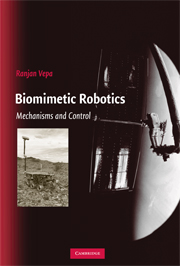Book contents
- Frontmatter
- Contents
- Preface
- Acronyms
- 1 The Robot
- 2 Biomimetic Mechanisms
- 3 Homogeneous Transformations and Screw Motions
- 4 Direct Kinematics of Serial Robot Manipulators
- 5 Manipulators with Multiple Postures and Compositions
- 6 Grasping: Mechanics and Constraints
- 7 Jacobians
- 8 Newtonian, Eulerian, and Lagrangian Dynamics
- 9 Path Planning, Obstacle Avoidance, and Navigation
- 10 Hamiltonian Systems and Feedback Linearization
- 11 Robot Control
- 12 Biomimetic Motive Propulsion
- Answers to Selected Exercises
- Appendix: Attitude and Quaternions
- Bibliography
- Index
2 - Biomimetic Mechanisms
Published online by Cambridge University Press: 20 February 2010
- Frontmatter
- Contents
- Preface
- Acronyms
- 1 The Robot
- 2 Biomimetic Mechanisms
- 3 Homogeneous Transformations and Screw Motions
- 4 Direct Kinematics of Serial Robot Manipulators
- 5 Manipulators with Multiple Postures and Compositions
- 6 Grasping: Mechanics and Constraints
- 7 Jacobians
- 8 Newtonian, Eulerian, and Lagrangian Dynamics
- 9 Path Planning, Obstacle Avoidance, and Navigation
- 10 Hamiltonian Systems and Feedback Linearization
- 11 Robot Control
- 12 Biomimetic Motive Propulsion
- Answers to Selected Exercises
- Appendix: Attitude and Quaternions
- Bibliography
- Index
Summary
Introduction
The concept of biomimetic control, i.e., control systems that mimic biological animals in the way they exercise control, rather than just humans, has led to the definition of a new class of biologically inspired robots that exhibit much greater robustness in performance in unstructured environments than the robots that are currently being built. It is believed that there is a duality between engineering and nature that is based on optimum use of energy or an equivalent scarce resource, particularly in exercising control over actions and over interactions with the immediate environment. Biomimesis is generally based on this concept, and it is believed that by mimicking animals that are most capable of performing certain specialized actions, such as the lobster on the seabed, insects and birds in flight, and cockroaches in locomotion, one could build robots that can surpass any other in performance, agility, and dexterity.
A key feature of biomimetic robots is their capacity to adapt to the environment and ability to learn and react fast. However, a biomimetic robot is not just about learning and adaptation but also involves novel mechanisms and manipulator structures capable of meeting the enhanced performance requirements. Thus biomimetic robots are being designed to be substantially more compliant and stable than conventionally controlled robots and will take advantage of new developments in materials, microsystems technology, as well as developments that have led to a deeper understanding of biological behavior.
Roboticists have a lot to learn from animals. Birds have a superior flying machine with multielement “aerofoils” capable of controlling the flow around them quite effortlessly.
- Type
- Chapter
- Information
- Biomimetic RoboticsMechanisms and Control, pp. 25 - 61Publisher: Cambridge University PressPrint publication year: 2009

